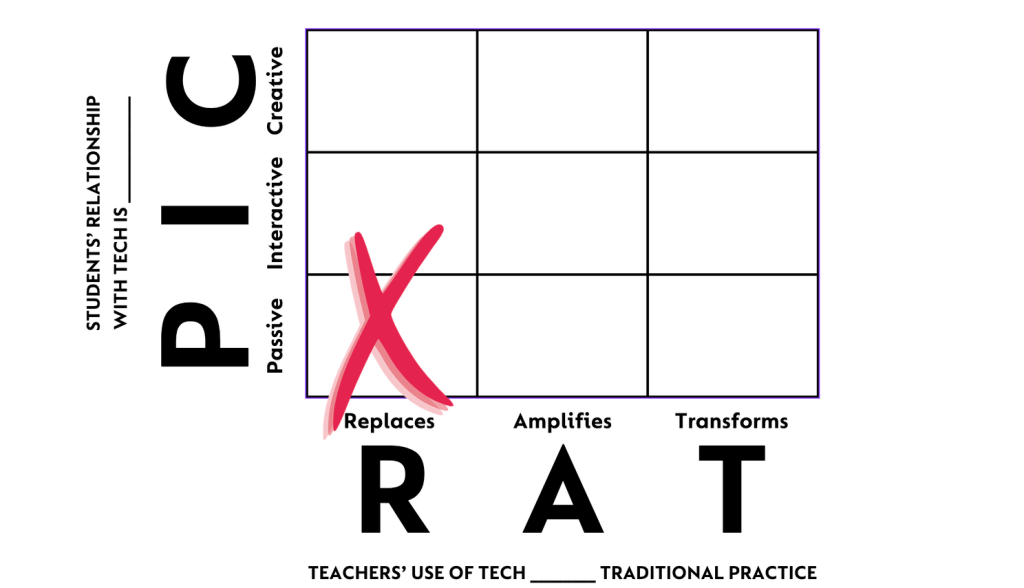13 February 2025
Using technology purposefully: Why PICRAT matters for our Digital Learning strategy
As we mark Digital Learning Day 2025, it’s essential to reflect not just on how we use technology in education, but why it matters at an organisational level. The conversation should go beyond simply increasing technology use in classrooms; instead, we must focus on the impact it has on student learning and engagement.
This is where the PICRAT framework provides a valuable lens. Developed as a practical, teacher-friendly model, PICRAT helps schools assess and improve digital integration without overwhelming educators. Rather than pushing for radical shifts, it encourages small but meaningful steps that build teacher confidence and enhance student outcomes.
Andy Perryer, our Head of Digital Learning, explores how to use PICRAT to measure how technology really impacts learning in this recent article. An extract can be read below:
Over the years, many digital learning models have been developed to help educators make sense of how we use technology in the classroom. From the SAMR (Substitution, Augmentation, Modification, Redefinition) model to TPACK (Technological Pedagogical Content Knowledge) and even Prof. Kevin Burden’s MPF (Mobile Pedagogical Framework), each framework offers a unique perspective on the role and impact of technology in education. However, these models can sometimes feel abstract or overwhelming, making it difficult for teachers to put theory into practice.
Ever since stumbling upon it, I have been enamoured with the PICRAT framework. It simplifies this complexity by providing a structured approach for educators and school leaders to evaluate the integration of technology into the student learning experience. Developed by Brigham Young University researchers Royce Kimmons, Charles Graham and Richard West in 2020, PICRAT simplifies other technology integration models by combining two dimensions – student engagement and its educational impact. This two-axis framework is designed to help educators reflect on how technology is being used in the classroom and identify areas for improvement
What is the PICRAT framework?
The name PICRAT is derived from the two dimensions it uses:
What is the students’ relationship with technology?
P – Passive: Students receive information without interacting with the content. For example, watching a video or listening to a lecture.
I – Interactive: Students engage with content through activities such as answering questions embedded in a video or participating in a discussion.
C – Creative: Students use technology to create something new, such as a digital project or a multimedia presentation. This requires the application of knowledge and higher-order thinking.
What does the teachers’ use of tech do compared to traditional practice?
R – Replacement: Technology replaces a traditional tool without changing the learning experience (e.g. reading an e-book instead of a printed book).
A – Amplification: Technology enhances the learning experience by making it more efficient, engaging or accessible (e.g. using an online platform for collaborative annotation of a text).
T – Transformation: Technology fundamentally changes the learning experience by enabling new tasks or outcomes that were previously impossible (e.g. using virtual reality to simulate historical events).
These dimensions intersect to create a nine-cell matrix, with each cell representing a unique combination of student engagement and its pedagogical impact. For example, an activity in which students watch a video (passive-replacement) would fall into a different cell than an activity in which they use video-editing software to create their own documentaries (creative-transformation).

Why this matters for Cognita
Strategic digital adoption – Schools often face pressure to adopt the latest EdTech tools, but how do we know what really makes a difference? PICRAT cuts through the noise, ensuring technology is used purposefully to amplify or transform learning, rather than simply replacing traditional methods.
Empowering educators – A culture of continuous improvement is key to any digital learning strategy. PICRAT provides a structured yet flexible way for educators to experiment, reflect, and grow, rather than feel pressured to achieve “transformation” in every lesson.
Student-centered learning – The framework reminds us that the goal of digital integration isn’t just efficiency—it’s active engagement and deeper learning. Encouraging movement from passive to interactive to creative use of technology ensures that students are not just consuming content but creating and applying knowledge.
Applying this thinking in practice
School leaders can use PICRAT during learning walks to observe and discuss how technology is being used in classrooms. This shifts the focus from “Is technology present?” to “How is it enhancing learning?”—a crucial distinction that aligns with our commitment to meaningful digital transformation.
For those interested in exploring this further, Andy Perryer’s article provides an excellent breakdown of how PICRAT works and why it’s a game-changer for digital learning conversations.

